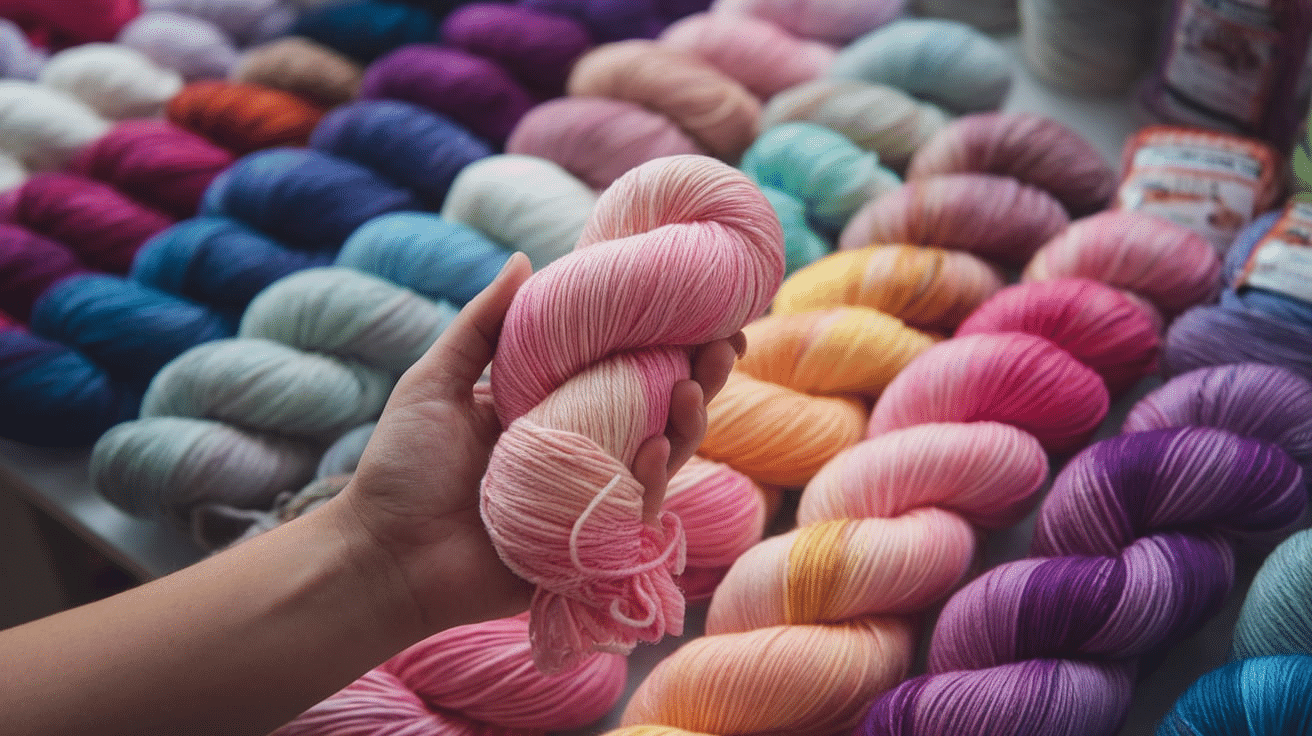Acrylic yarn is a popular choice for knitting and crocheting. But what exactly is it made of? Unlike natural fibers like wool or cotton, acrylic yarn is made from synthetic materials, mainly plastic.
It’s created by turning a liquid form of plastic into thin fibers, which are then spun into yarn. This yarn is known for being soft, lightweight, and easy to care for, making it a go-to for many craft projects.
Acrylic yarn is also affordable and comes in many colors, making it a great choice for beginners and experienced crafters alike. In this article, we’ll look at what acrylic yarn is made of and why it’s so popular in the crafting world.
What is Acrylic Yarn?

Acrylic yarn is a type of synthetic yarn made from acrylic fibers. It is a man-made material, which means it’s not made from natural fibers like cotton, wool, or silk.
Instead, acrylic yarn is made from a synthetic polymer, usually derived from petroleum. The result is a versatile, lightweight, and affordable yarn that is widely used in the crafting community.
The Composition of Acrylic Yarn

Acrylic yarn is made from a type of plastic called polyacrylonitrile. This material is a synthetic fiber, meaning it’s man-made and not found in nature and it is heated and turned into threads that can be spun into yarn. The best part is that it feels a lot like wool but is much cheaper and can be machine-washed. Below is the entire process of making an acrylic yarn:
The Process of Making Acrylic Yarn
This polymer is derived from petroleum-based chemicals, and the process of turning it into yarn involves several key steps:
1. Polymer Creation: Polyacrylonitrile
The primary ingredient in acrylic yarn is polyacrylonitrile, a type of polymer that forms the backbone of acrylic yarn.
Polyacrylonitrile is a synthetic material created by the chemical reaction of acrylonitrile, a liquid form of plastic. The polymerization process links the acrylonitrile molecules together, forming long chains of molecules.
2. Extrusion: Turning Polymer into Fibers
Once polyacrylonitrile is formed, the next step is extrusion, where the polymer is heated and forced through small holes in a machine known as a spinneret. This step turns the liquid polymer into thin fibers, which are the base of acrylic yarn.
The extrusion process can be adjusted to create different fiber thicknesses, allowing manufacturers to make acrylic yarn suitable for a variety of craft projects.
3. Dyeing: Adding Color
After the fibers are formed, they are ready to be dyed. Dyeing is an important step in the creation of acrylic yarn because it adds vibrant colors to the fibers.
The dyeing process involves soaking the acrylic fibers in dye baths that can range from bright, bold colors to more muted, pastel shades.
The synthetic fibers in acrylic yarn absorb the dye well, allowing the yarn to come in a wide variety of colors.
4. Spinning: Turning Fibers into Yarn
Once the fibers are dyed, they are ready to be spun into yarn. Spinning is the process of twisting the individual fibers together to form long threads.
The spinning process determines the yarn’s final texture, thickness, and strength. Acrylic yarn can be spun in various ways, resulting in different textures, from smooth and soft to more textured and chunky.
The more tightly the fibers are spun, the stronger the yarn becomes.
5. Finishing: Final Touches
The final step in creating acrylic yarn is the finishing process, where the yarn is treated to give it its final texture.
Some acrylic yarns are brushed to make them extra soft, while others might be given a more textured or twisted finish for added strength. The finishing process ensures that the yarn is ready for knitting, crocheting, or any other craft project.
Why Acrylic Yarn is Made the Way It Is
The process of turning polyacrylonitrile into yarn involves a combination of chemical and physical processes that allow the creation of a versatile, affordable, and suitable material for a wide range of projects.
Acrylic yarn’s synthetic nature gives it several advantages over natural yarns, such as affordability, durability, and ease of care.
Properties of Acrylic Yarn

The acrylic yarn has many unique properties that make it a favorite among crafters.
Softness
Acrylic yarn is known for being soft and comfortable to work with. It’s gentle on the skin, which makes it perfect for making scarves, hats, blankets, and other clothing items.
Lightweight
One of the main advantages of acrylic yarn is that it is lightweight. This makes it easy to work with, especially for beginners.
It’s also perfect for projects where you need to create something that isn’t too heavy, like summer wear or lightweight blankets.
Durability
Acrylic yarn is incredibly durable. It can withstand a lot of wear and tear, making it a good choice for items that will be used frequently, like blankets and baby clothes.
It also holds up well to repeated washing, which is why many people choose acrylic for garments and accessories.
Affordable
One of the most appealing aspects of acrylic yarn is its cost. Compared to natural fibers like wool or cotton, acrylic yarn is much more affordable.
This makes it a great option for people who are just starting out with crafting, as well as for larger projects where cost might be a concern.
Color Variety
Acrylic yarn comes in a wide range of colors, which is another reason it’s so popular. Whether you’re looking for a soft pastel shade or a bold, vibrant color, there’s an acrylic yarn to fit your needs.
The dyeing process allows for an almost endless variety of colors and shades, making it easy to find the perfect match for any project.
Easy to Care For
Acrylic yarn is known for being easy to care for. It’s machine washable and doesn’t shrink or lose its shape easily.
This makes it a practical choice for projects that will be regularly washed, like baby blankets, scarves, or even toys. You don’t need to worry about delicate hand-washing or dry cleaning.
Hypoallergenic
Since acrylic yarn is made from synthetic fibers, it is hypoallergenic, which means it’s less likely to cause allergic reactions.
This is an important consideration for people who are sensitive to natural fibers like wool.
Versatility
Acrylic yarn can be used in a variety of craft projects, from knitting and crocheting to weaving and even making amigurumi (small crocheted stuffed animals).
It can be used to create everything from soft blankets to stylish garments and accessories. Its versatility makes it a go-to option for many different kinds of projects.
Why is Acrylic Yarn Popular?
There are many reasons why acrylic yarn is so popular among knitters, crocheters, and other crafters.
1. Affordable and Accessible: Acrylic yarn is affordable and easy to find. Most craft stores carry a variety of acrylic yarn, and it’s often one of the least expensive options available.
2. Easy to Work With: Acrylic yarn is soft, smooth, and lightweight, making it easy to work with. It’s ideal for beginners who are learning to knit or crochet.
3. Durable and Long-Lasting: Acrylic yarn holds up well over time, even after repeated washing and use. This makes it a great choice for items like blankets, scarves, and hats that must last for years.
4. Works Well for Many Projects: Acrylic yarn works well for various projects. Acrylic yarn can do the job while making clothes, toys, blankets, or home décor items.
5. Works for All Seasons: Acrylic yarn is perfect for all projects, regardless of the season. It can be used for lightweight summer items, like tops and shawls, and heavier winter projects, like scarves, hats, and blankets.
Comparing Acrylic Yarn to Other Types of Yarn

Acrylic yarn isn’t the only type of yarn available. There are many other yarns made from natural fibers, such as wool, cotton, and bamboo. Let’s compare acrylic yarn to some of these popular types:
| Feature | Acrylic Yarn | Wool Yarn | Cotton Yarn | Bamboo Yarn |
|---|---|---|---|---|
| Material | Synthetic (polyacrylonitrile) | Natural (sheep’s wool) | Natural (cotton plant fibers) | Natural (bamboo plant fibers) |
| Softness | Soft, but not as soft as wool | Very soft and warm | Soft, but can be stiff | Smooth and soft |
| Warmth | Lightweight, not very warm | Excellent for cold weather | Light, not warm | Light and breathable |
| Stretch | Slightly stretchy | Natural stretch, very elastic | Little Stretch | Moderate stretch |
| Breathability | Moderate | Breathable and moisture-wicking | Highly breathable | Breathable and smooth |
| Hypoallergenic | Yes | No, it can cause allergies | Yes | Yes |
| Durability | Very durable, easy to care for | Durable, but can wear out | Less durable, can shrink | Less durable, can lose shape |
| Care | Easy care, machine washable | Requires special care, hand wash | Machine washable | Hand wash or gentle machine wash |
| Cost | Affordable | Expensive | Moderate | Expensive |
| Best For | Versatile, affordable projects | Cold-weather wear, luxury items | Summer wear, dishcloths | Soft, smooth garments, eco-friendly items |
| Color Variety | Wide range of colors | Limited color choices | Limited color choices | Limited color choices |
Conclusion
Acrylic yarn is made from synthetic fibers, specifically a polymer called polyacrylonitrile. It is affordable, soft, durable, and easy to care for, making it a popular choice among crafters.
Acrylic yarn can be used for many different types of projects, from clothing to home décor, and it comes in a wide range of colors. It’s also a great choice for beginners due to its affordability and ease of use.
Understanding what acrylic yarn is made of can help you choose the right yarn for your next craft project.
If you’re knitting, crocheting, or making something entirely new, acrylic yarn is a versatile option that will help bring your creative ideas to life.
Frequently Asked Questions
Is acrylic yarn eco-friendly?
Acrylic yarn is not considered fully eco-friendly, as it is made from petroleum-based products. However, it is often more durable and long-lasting, which reduces waste over time.
Can acrylic yarn be used for baby items?
Yes, acrylic yarn is often used for baby items like blankets and hats. It’s hypoallergenic, soft, and easy to care for, making it a great choice for sensitive skin.
How long does acrylic yarn last?
Acrylic yarn is known for its durability and can last for many years, especially if it is well cared for. Its resistance to wear and tear makes it ideal for items used frequently.
Can you mix acrylic yarn with other fibers?
Yes, acrylic yarn can be blended with other fibers like wool, cotton, or nylon to enhance its texture, durability, or elasticity, creating a variety of unique yarns.









